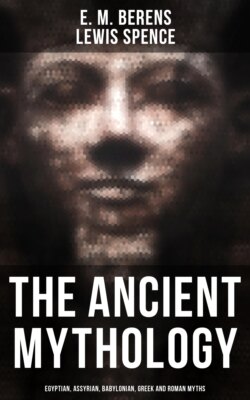Читать книгу The Ancient Mythology: Egyptian, Assyrian, Babylonian, Greek and Roman Myths - Lewis Spence - Страница 55
На сайте Литреса книга снята с продажи.
Ea
ОглавлениеEa was the third of the great Babylonian triad of gods, which consisted of Anu, En-lil, and himself. He was a god of the waters, and like Anu is called the 'father of the gods.' As a god of the abyss he appears to have been also a deity of wisdom and occult power, thus allegorically associated with the idea of depth or profundity. He was the father of Merodach, who consulted him on the most important matters connected with his kingship of the gods. Indeed he was consulted by individuals of all classes who desired light to be thrown upon their crafts or businesses. Thus he was the god of artisans in general—blacksmiths, stone-cutters, sailors, and artificers of every kind. He was also the patron of prophets and seers. As the abyss is the place where the seeds of everything were supposed to fructify, so he appears to have fostered reproduction of every description. He was supposed to dwell beside Anu, who inhabited the pole of the ecliptic. The site of his chief temple was at Eridu, which at one time stood, before the waters receded, upon the shore of the Persian Gulf. We have seen already that Ea, under his Greek name of Oannes, was supposed to bring knowledge and culture to the people of Eridu. There are many confusing myths connected with him, and he seems in some measure to enter into the Babylonian myth of the deluge. Alexander Polyhistor, Apollodorus, and Eusebius, copying from Berossus, state that he rose from the sea upon his civilizing mission, and Abydenus says that in the time of Daon, the shepherd king of the city of Pantibiblon (meaning the 'city where books were gathered together'), "Annedatus appeared again from the Eruthrean sea, in the same form as those who had showed themselves before, having the shape of a fish blended with that of a man. Then reigned Aedorachus of Pantibiblon for the term of eighteen sari. In his days there appeared another personage from the sea of Eruthra, like those above, having the same complicated form between fish and man: his name was Odacon." From remarks by Apollodorus it would seem that these beings were messengers from Oannes, but the whole passages are very obscure. The chief extract from the fragments of Berossus concerning Oannes states that: "In the first year there made its appearance from a part of the Eruthrean sea, which bordered upon Babylonia, an animal endowed with reason, who was called Oannes. According to the accounts of Apollodorus the whole body of the animal was like that of a fish; and had under a fish's head another head, and also feet below, similar to those of a man, subjoined to the fish's tail. His speech, too, was articulate and human; and there was a representation of him to be seen in the time of Berossus. This Being in the daytime used to converse with men; but took no food at that season; and he gave them an insight into letters and science, and every kind of art. He taught them to construct houses, to found temples, to compile laws, and explained to them the principles of geometrical knowledge. He made them distinguish the seeds of the earth, and showed them how to collect fruits; in short, he instructed them in everything which could tend to soften manners and humanize mankind. From that time, so universal were his instructions, nothing material has been added by way of improvement. When the sun set, it was the custom of this Being to plunge again into the sea, and abide all the night in the deep." After this there appeared other creatures like Oannes, of which Berossus promises to give an account when he comes to the history of the kings.
